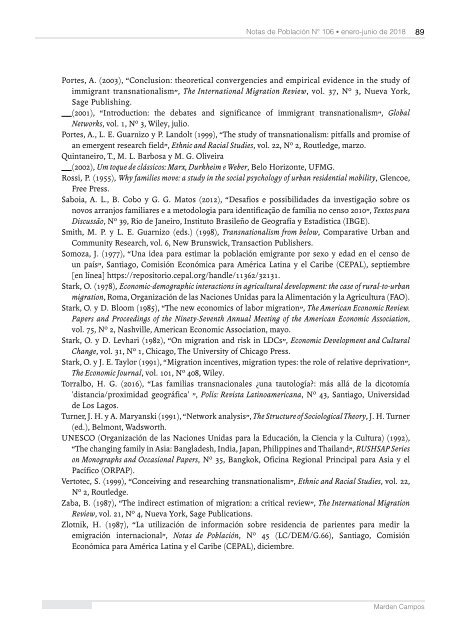Notas de Población N° 106
El número 106 de Notas de Población está conformado por 10 artículos, en cuya elaboración han participado 21 colaboradores. Los artículos abordan diversos temas de investigación relacionados con la mortalidad, el transnacionalismo migratorio y la fecundidad de las migrantes, así como la fecundidad adolescente, el femicidio, la migración de retorno, la segregación en el espacio urbano y el dividendo demográfico.
El número 106 de Notas de Población está conformado por 10 artículos, en cuya elaboración han participado 21 colaboradores. Los artículos abordan diversos temas de investigación relacionados con la mortalidad, el transnacionalismo migratorio y la fecundidad de las migrantes, así como la fecundidad adolescente, el femicidio, la migración de retorno, la segregación en el espacio urbano y el dividendo demográfico.
You also want an ePaper? Increase the reach of your titles
YUMPU automatically turns print PDFs into web optimized ePapers that Google loves.
<strong>Notas</strong> <strong>de</strong> <strong>Población</strong> <strong>N°</strong> <strong>106</strong> • enero-junio <strong>de</strong> 2018<br />
89<br />
Portes, A. (2003), “Conclusion: theoretical convergencies and empirical evi<strong>de</strong>nce in the study of<br />
immigrant transnationalism”, The International Migration Review, vol. 37, Nº 3, Nueva York,<br />
Sage Publishing.<br />
(2001), “Introduction: the <strong>de</strong>bates and significance of immigrant transnationalism”, Global<br />
Networks, vol. 1, Nº 3, Wiley, julio.<br />
Portes, A., L. E. Guarnizo y P. Landolt (1999), “The study of transnationalism: pitfalls and promise of<br />
an emergent research field”, Ethnic and Racial Studies, vol. 22, Nº 2, Routledge, marzo.<br />
Quintaneiro, T., M. L. Barbosa y M. G. Oliveira<br />
(2002), Um toque <strong>de</strong> clássicos: Marx, Durkheim e Weber, Belo Horizonte, UFMG.<br />
Rossi, P. (1955), Why families move: a study in the social psychology of urban resi<strong>de</strong>ntial mobility, Glencoe,<br />
Free Press.<br />
Saboia, A. L., B. Cobo y G. G. Matos (2012), “Desafios e possibilida<strong>de</strong>s da investigação sobre os<br />
novos arranjos familiares e a metodologia para i<strong>de</strong>ntificação <strong>de</strong> família no censo 2010”, Textos para<br />
Discussão, Nº 39, Río <strong>de</strong> Janeiro, Instituto Brasileño <strong>de</strong> Geografía y Estadística (IBGE).<br />
Smith, M. P. y L. E. Guarnizo (eds.) (1998), Transnationalism from below, Comparative Urban and<br />
Community Research, vol. 6, New Brunswick, Transaction Publishers.<br />
Somoza, J. (1977), “Una i<strong>de</strong>a para estimar la población emigrante por sexo y edad en el censo <strong>de</strong><br />
un país”, Santiago, Comisión Económica para América Latina y el Caribe (CEPAL), septiembre<br />
[en línea] https://repositorio.cepal.org/handle/11362/32131.<br />
Stark, O. (1978), Economic-<strong>de</strong>mographic interactions in agricultural <strong>de</strong>velopment: the case of rural-to-urban<br />
migration, Roma, Organización <strong>de</strong> las Naciones Unidas para la Alimentación y la Agricultura (FAO).<br />
Stark, O. y D. Bloom (1985), “The new economics of labor migration”, The American Economic Review.<br />
Papers and Proceedings of the Ninety-Seventh Annual Meeting of the American Economic Association,<br />
vol. 75, Nº 2, Nashville, American Economic Association, mayo.<br />
Stark, O. y D. Levhari (1982), “On migration and risk in LDCs”, Economic Development and Cultural<br />
Change, vol. 31, Nº 1, Chicago, The University of Chicago Press.<br />
Stark, O. y J. E. Taylor (1991), “Migration incentives, migration types: the role of relative <strong>de</strong>privation”,<br />
The Economic Journal, vol. 101, Nº 408, Wiley.<br />
Torralbo, H. G. (2016), “Las familias transnacionales ¿una tautología?: más allá <strong>de</strong> la dicotomía<br />
'distancia/proximidad geográfica' ”, Polis: Revista Latinoamericana, Nº 43, Santiago, Universidad<br />
<strong>de</strong> Los Lagos.<br />
Turner, J. H. y A. Maryanski (1991), “Network analysis”, The Structure of Sociological Theory, J. H. Turner<br />
(ed.), Belmont, Wadsworth.<br />
UNESCO (Organización <strong>de</strong> las Naciones Unidas para la Educación, la Ciencia y la Cultura) (1992),<br />
“The changing family in Asia: Bangla<strong>de</strong>sh, India, Japan, Philippines and Thailand”, RUSHSAP Series<br />
on Monographs and Occasional Papers, Nº 35, Bangkok, Oficina Regional Principal para Asia y el<br />
Pacífico (ORPAP).<br />
Vertotec, S. (1999), “Conceiving and researching transnationalism”, Ethnic and Racial Studies, vol. 22,<br />
Nº 2, Routledge.<br />
Zaba, B. (1987), “The indirect estimation of migration: a critical review”, The International Migration<br />
Review, vol. 21, Nº 4, Nueva York, Sage Publications.<br />
Zlotnik, H. (1987), “La utilización <strong>de</strong> información sobre resi<strong>de</strong>ncia <strong>de</strong> parientes para medir la<br />
emigración internacional”, <strong>Notas</strong> <strong>de</strong> <strong>Población</strong>, Nº 45 (LC/DEM/G.66), Santiago, Comisión<br />
Económica para América Latina y el Caribe (CEPAL), diciembre.<br />
Mar<strong>de</strong>n Campos


















